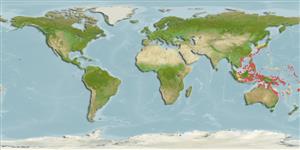>
Blenniiformes (Blennies) >
Tripterygiidae (Triplefin blennies) > Tripterygiinae
Etymology: Enneapterygius: Greek, ennea = nine times + Greek, pterygion = little fin (Ref. 45335).
More on author: Fricke.
Environment: milieu / climate zone / Tiefenbereich / distribution range
Ökologie
seewasser riff-verbunden; tiefenbereich 0 - 18 m (Ref. 27223). Tropical
Western Pacific: Japan, Taiwan, Philippines, Indonesia, Papua New Guinea, Australia, Palau, and Guam.
Size / Gewicht / Alter
Geschlechtsreife: Lm ? range ? - ? cm
Max length : 4.0 cm TL Männchen/unbestimmt; (Ref. 90102)
Kurzbeschreibung
Bestimmungsschlüssel | Morphologie | Morphometrie
Rückenflossenstacheln (insgesamt) : 14 - 18; Rückenflossenweichstrahlen (insgesamt) : 6 - 11; Afterflossenstacheln: 1; Afterflossenweichstrahlen: 16 - 20. Male with reddish head and body, row of white blotches along side, additional row of white saddles on back, blackish tail, and black "mask" on front and lower half of head. Female translucent yellowish or orange with faint dark saddles/streaks on back. Dorsal rays III + XI-XV + 6-11; anal rays I,16-20; pectoral rays 16-18; pelvic rays I,2; lateral line interrupted, 13-20 + 13-22; head, chest, and pectoral-fin base scaleless; simple orbital tentacle present; mandibular pores 3-6 + 2-8 + 3-6. Maximum size to 4 cm TL (Ref. 90102).
Body shape (shape guide): elongated.
Adults occur in shallow waters, mainly on the reef flat or crest. They are found on shady vertical rock walls with some current and relatively high oxygen level (Ref. 27223). Eggs are hemispherical and covered with numerous sticky threads that anchor them in the algae on the nesting sites (Ref. 240). Larvae are planktonic which occur primarily in shallow, nearshore waters (Ref. 94114).
Life cycle and mating behavior
Geschlechtsreife | Fortpflanzung | Ablaichen | Eier | Fecundity | Larven
Fricke, R., 1997. Tripterygiid fishes of the western and central Pacific, with descriptions of 15 new species, including an annotated checklist of world Tripterygiidae (Teleostei). Theses Zool. 29:1-607. (Ref. 27223)
IUCN Rote Liste Status (Ref. 130435: Version 2025-1)
Bedrohung für Menschen
Harmless
Nutzung durch Menschen
Fischereien: nicht kommerziell
Tools
Zusatzinformationen
Download XML
Internet Quellen
Estimates based on models
Preferred temperature (Ref.
123201): 24.7 - 29.3, mean 28.5 °C (based on 1586 cells).
Phylogenetic diversity index (Ref.
82804): PD
50 = 0.5000 [Uniqueness, from 0.5 = low to 2.0 = high].
Bayesian length-weight: a=0.00617 (0.00288 - 0.01322), b=3.04 (2.86 - 3.22), in cm total length, based on LWR estimates for this (Sub)family-body shape (Ref.
93245).
Trophic level (Ref.
69278): 3.1 ±0.3 se; based on size and trophs of closest relatives
Widerstandsfähigkeit (Ref.
120179): hoch, Verdopplung der Population dauert weniger als 15 Monate. (Preliminary K or Fecundity.).
Fishing Vulnerability (Ref.
59153): Low vulnerability (10 of 100).
🛈
